Learning the instruments of the orchestra opens up a whole new magical world and one that we will learn about now! In this post we will focus on the symphony or philharmonic orchestra.
If you are taking a Music Theory exam, it is important that you learn about different orchestral instruments. Check out our beginners’ guide to Grade 5 Music Theory which breaks down how to prepare for this important exam.
The instruments of the orchestra are divided into four different families. These are the:
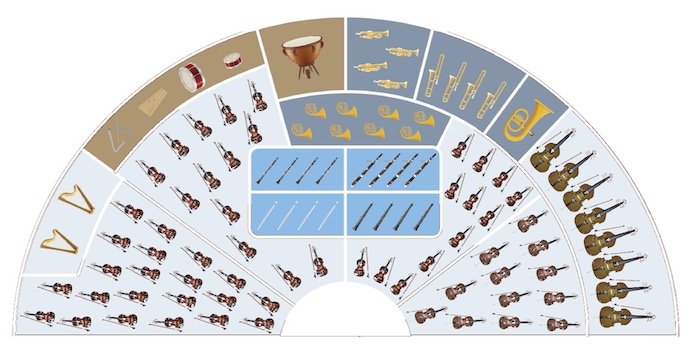
String Instruments
Within the string family there are four main musical instruments in the symphony orchestra. These are the:
- Violin
- Viola
- Cello
- Double Bass
- Harp
Let’s look at these five instruments within the string section.
Violin
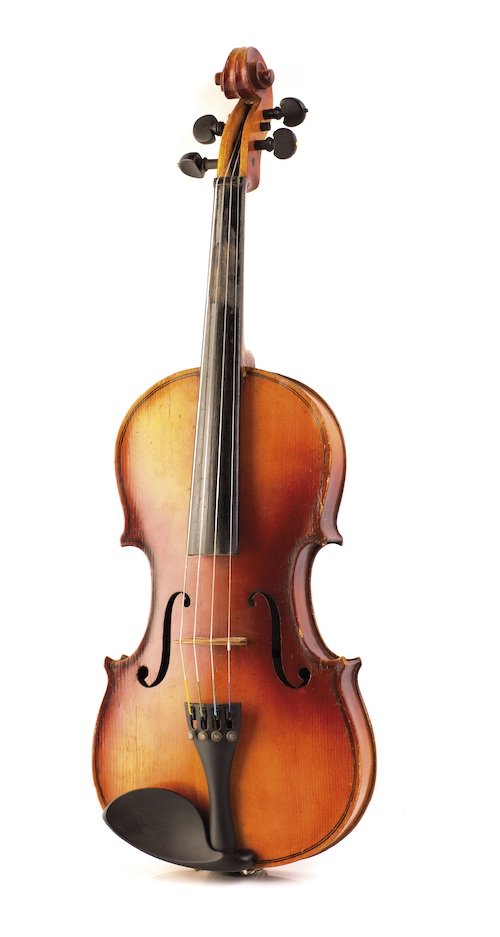
Violins make up the largest section of all orchestras. There are so many violins in the orchestra that they actually are divided into two sections, the first violin section and the second violin section. The first violins will typically play the main melodies and will have higher notes than the second violins! The second violins, although they will have the tune/melodies sometimes, will mostly have the harmony.
The violin is reasonably small and made out of wood. It has four strings and these strings are either played using your fingers or a bow! The bow is made out of a thin piece of wood and horse hair!
The violin read its music in the treble clef.
Viola

The viola is very similar to the violin in how it looks and how it is played, with one difference – it is much larger and the strings are tuned differently!
The viola reads its music in the alto clef.
The viola typically only has one section in the orchestra and they are responsible mostly for the harmonies.
Cello
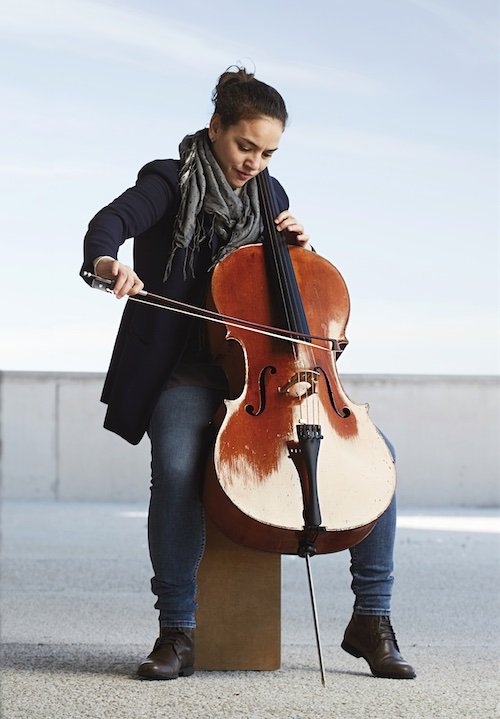
The cello looks similar to the violin and viola but it is a lot larger! So much larger in fact that we have to place it on the floor using a spike that comes out of the bottom of the instrument.
The cello also has one section in the orchestra. It reads it’s music in the bass clef.
The cello is also played using the fingers or a bow. The sound the cello produces is much lower than that of the violin and viola!
Double Bass

The next instrument in the string family is the double bass. The double bass is the largest of the string instruments. It also looks very similar to the other three different string instruments but is much larger! Double bass players will usually play this instrument standing up or sat on a tall stool.
There is one section of double bass players in the orchestra but it is the smallest section of bowed string instruments. The double bass reads it’s music in the bass clef.
The double bass has the lowest pitch out of all of the string instruments and is also played with the fingers or (a very large!) bow!
Harp
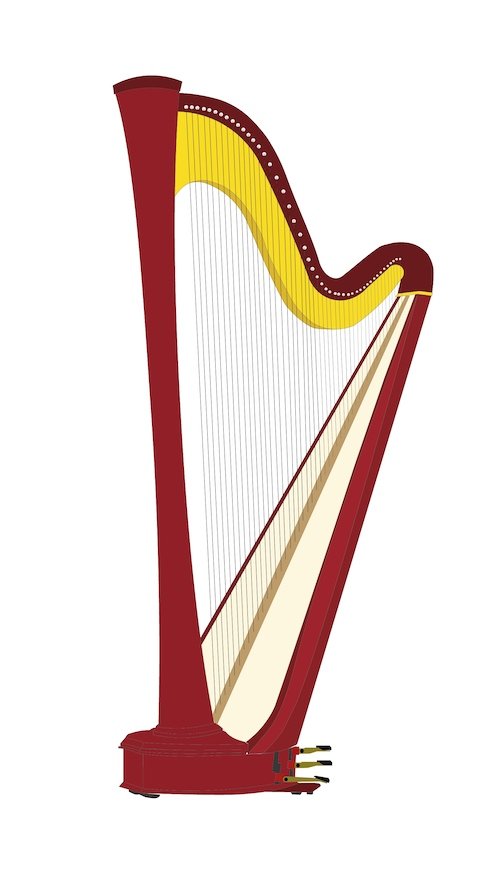
The harp is slightly different to the other string instruments and there is usually only one or two harps within a symphony orchestra.
The harp has many more strings, 47 to be exact! And is only played using the fingers on both hands. There are also a few pedals to help change the pitch of the strings. Very similar to the piano, the harp reads its music on the grand stave, including the treble and the bass clef.
Moving on now we will visit the woodwind instruments!
Woodwind Instruments
Within the woodwind instruments there are four main instruments.
- Flute
- Oboe
- Clarinet
- Bassoon
Alongside these instruments there are some supplementary woodwind instruments:
- Piccolo – a small, higher pitched flute
- Cor Anglais – a larger, lower pitched oboe
- Eb clarinet – a small, higher pitched clarinet
- Bass Clarinet – a larger, lower pitched clarinet
- Contrabassoon – a larger, lower pitched bassoon
There are some more supplementary instruments that go along with the woodwind instruments but this is a good place to start!
Flute
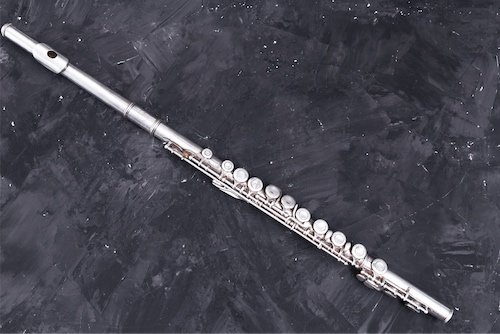
The flute is the highest instrument of the woodwind family. It is typically made out of metal and in order to make a sound you have to blow over the top of the hole. Like blowing over a bottle!
There are typically two flute players in an orchestra as well as one piccolo player. Both of these instruments read their music in the treble clef but the piccolo’s sounding pitch is actually one octave higher than what is written.
Oboe
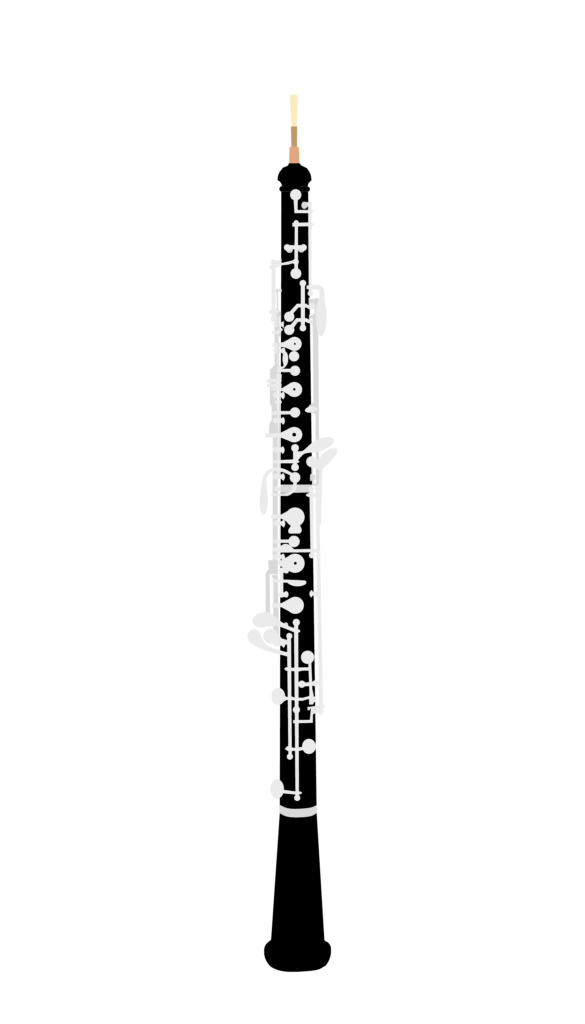
The oboe is a similar pitch to the flute but is played very differently. In order to play the oboe you must use what we call a ‘double reed’. A double reed consists of two thin pieces of wood tied together. The player will blow air directly through the middle to make them vibrate! This produces a characteristic penetrating sound. There are not as many harmonics in an oboe sound which gives it this feature. An oboe is typically used to tune the whole orchestra as it can be heard much clearer than many other instruments!
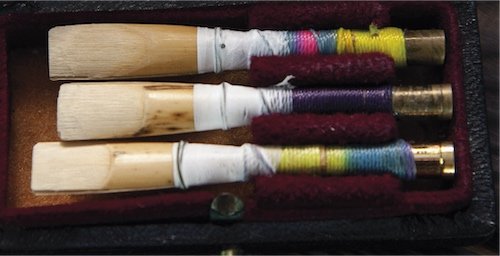
There is usually two oboe players and sometimes one cor anglais player in an orchestra. The cor anglais looks very much like the oboe but with a large ball shape at the bottom. It has a lower pitch but will still use the double reed. The cor anglais is also a transposing instrument, where the oboe is not!
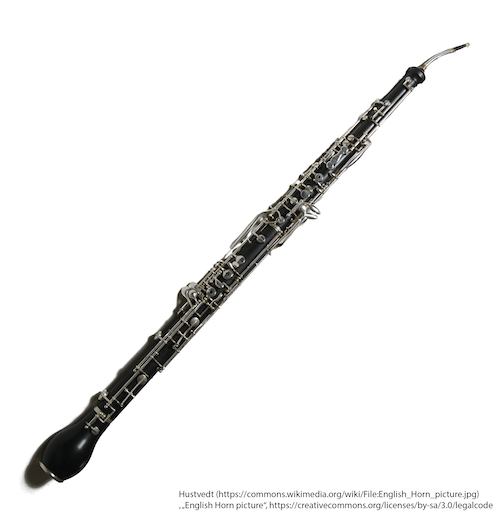
Clarinet
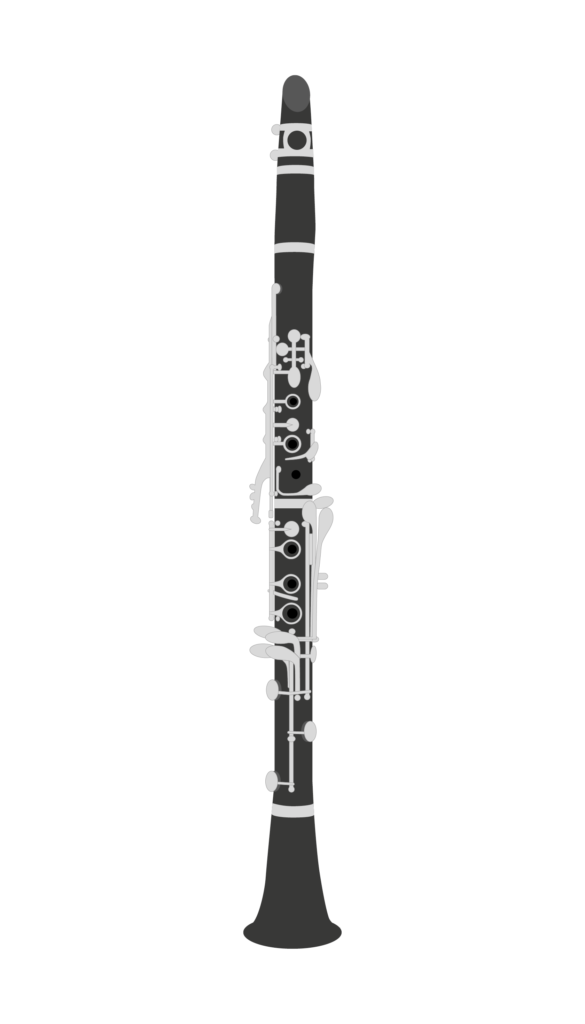
TThe clarinet looks quite similar to the oboe in that it is made of wood with metal keys. However, it is played very differently! The clarinet, also uses a reed but this type of reed is called a single reed. This is because it is attached to a mouth piece. The player will blow air between the reed and the mouth piece to cause the vibration to make a sound.
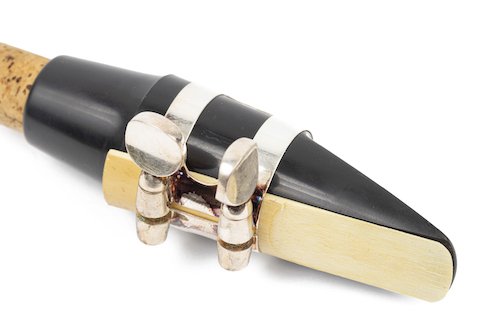
The clarinet is a transposing instrument. This simply means that when the clarinet plays a C natural, we actually hear a B flat a major 2nd lower. Learn how to transpose by a Major 2nd here.
The clarinet produces quite a mellow sound. Again, there are typically two clarinets in an orchestra and sometimes a bass clarinet! The bass clarinet looks very similar to the clarinet but is much larger with a silver bell on the end.
Bassoon
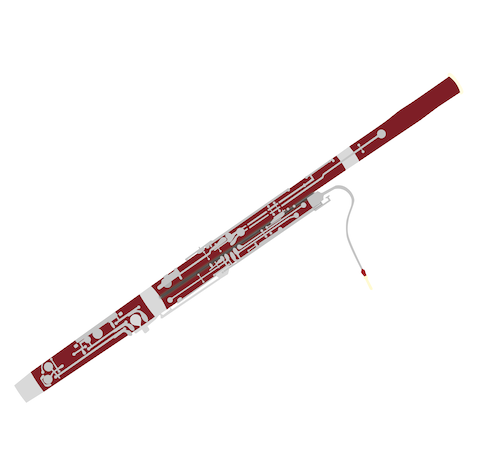
The lowest member of the woodwind family is the bassoon! The bassoon is a large tube of wood that is held to the side of the players body. There is a large silver crook placed in the middle where a double reed is put on the end. This double reed is very similar to that of the oboes but the reed is larger!
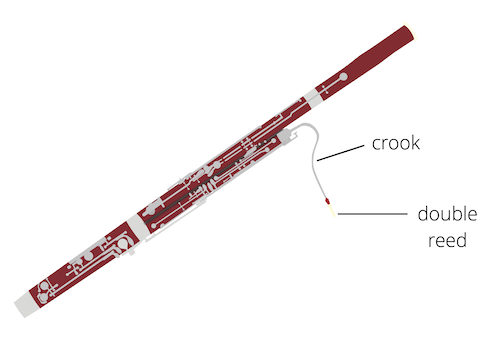
There are most usually two bassoons in an orchestra and sometimes you will see a contrabassoon. The contrabassoon is much larger with many tubes wrapped round each other! The sound is much lower than all the other woodwind instruments.
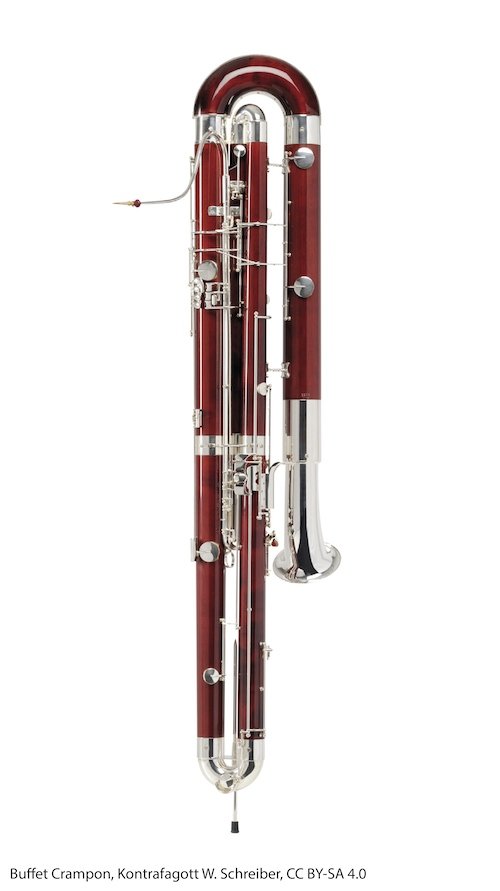
Brass Instruments
The next family in in the orchestra is the brass family! The brass family has four main members, the trumpet, the French horn, the trombone and the tuba.
Trumpet
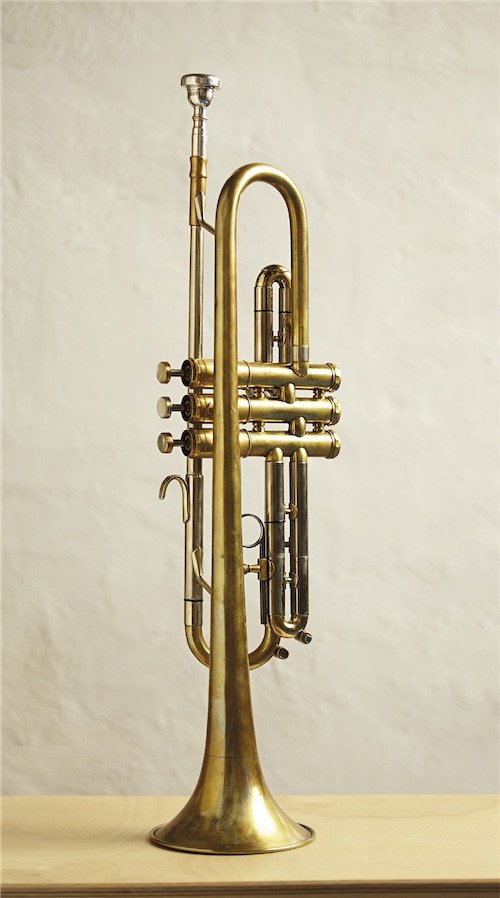
The trumpet is the highest of the brass instruments. It is made of brass and is played by blowing through a mouthpiece! We can then change the pitch by altering the air pressure and also by pressing down one of the three valves.
The trumpet is a transposing instrument and much like the clarinet is in the key of Bb. This means that when the trumpet plays a C natural, we hear a B flat! For more on this topic, check out our introduction to transposition.
There are typically two trumpets in an orchestra although there can be more!
French Horn

Moving through the brass instruments, we get to the French horn. The French horn is also made of brass but it has much longer tubing that is curved around. At the end of the tubing is a very large bell, this is where the sound will come out. The French horn is also played by blowing air through the mouthpiece. We alter the pitch by changing the air pressure but also by pressing the three valves.
The French horn is also a transposing instrument and is in the key of F! This means that when the French horn plays a C natural, we hear an F. This is a perfect 5th lower. Learn how to transpose down a perfect 5th with our transposition lessons.
Typically there are two French horn parts in the orchestra but commonly there are more as doubles! Because the mouth piece of a French horn is very small the performers lips can get very tired and so it is definitely handy to have a double!
Trombone
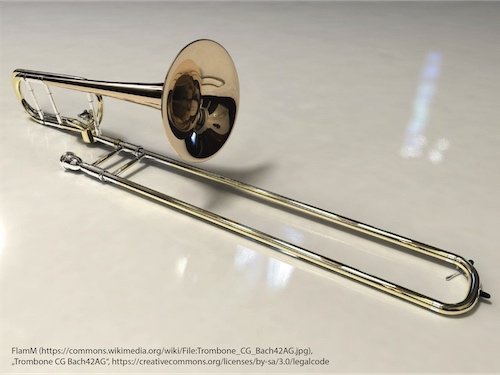
The trombone is a little different to both the trumpet and the French horn in that it has no valves! Rather than pressing a valve down to help produce the pitch, the trombone uses a slide. The slide is moved up and down to different areas on the tube to help produce the correct pitch.
There are usually four trombones in the orchestra.
Tuba
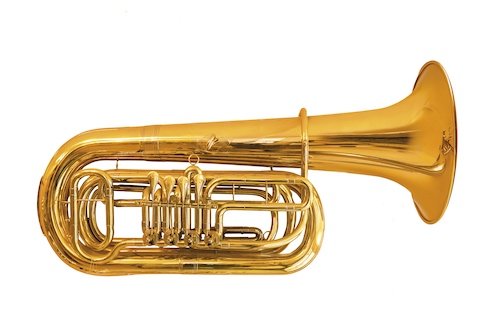
The final instrument in the brass family is the tuba. The tuba is the largest and also the lowest member of this family! Similar to the trumpet and the French horn, we produce a sound by vibrating the lips. The tuba also has three valves which can be pressed to help alter the pitch. These valves are pressed to produce the desired pitch.
There is usually only one tuba in the orchestra.
Percussion Instruments
The final family in the orchestra is the percussion family, the percussion family consists of any instrument that can be struck with either your hands or a stick. The percussion family can have many different members and so we will look at some of the most typical ones here. They can be divided into two categories: definite pitch and indefinite pitch
Definite Pitch
Let’s look at some of the instruments that have definite pitch. This simply means that we know in advance what pitch the instrument will play when struck. Some of the most typical instruments in this category are:
Timpani
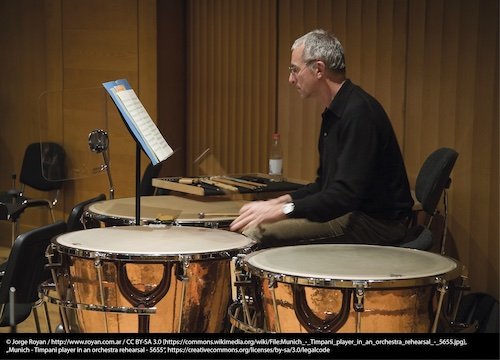
The timpani, also called the kettle drum, is a large drum. This is struck with a soft beater and you will usually see at least three of these in the percussion section of the orchestra. Each drum will have a different pitch.
Xylophone
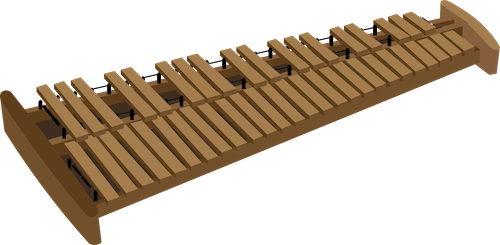
The xylophone consists of horizontal wooden bars that are struck with wooden beaters. The pitch will vary depending on the size of the wooden bar.
Celesta
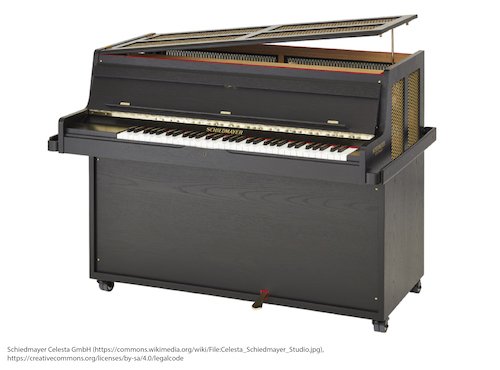
The celesta looks very much like a piano but is much smaller in size. Inside there are metal bars which give it the characteristic bell sound.
Indefinite Pitch
Percussion instruments with indefinite pitch are those where we do not know the pitch that will come out. These instruments are used more for effect in the orchestra! Here are a few most common ones:
Snare Drum
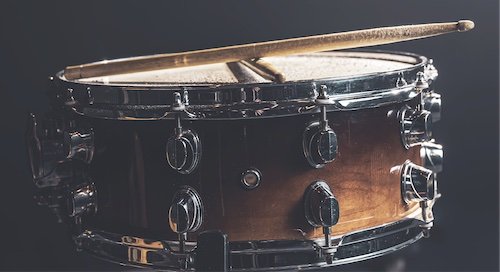
This is also sometimes called a side drum and is struck with a beater. It produces a strong and sharp sound, this is due to the stiff wires stretched underneath the drum.
Cymbals
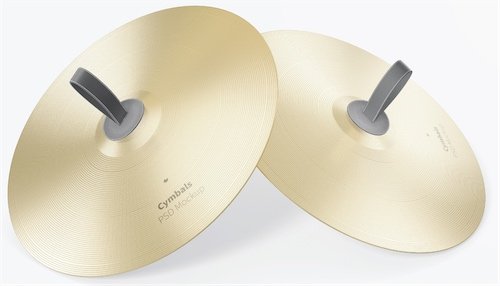
Cymbals often come in pairs and consist of thin gold discs. Cymbals can played in two different ways, either by being struck with a beater or crashed together!
Tambourine
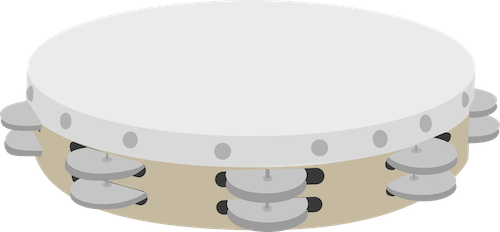
The tambourine is small and drum like in shape. Around the edge of the drum are small gold discs called ‘zills’. The tambourine can be struck or shaken by the hand.
There are many more percussion instruments out there but these are the main few!
Sometimes in an orchestra you may also see the piano. There is much debate as to whether the piano is in the string or the percussion family as it is both struck by the hands to produce the sound but inside there are many strings!
